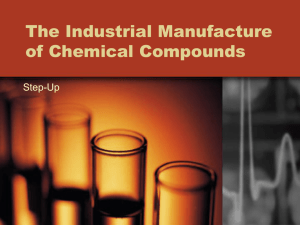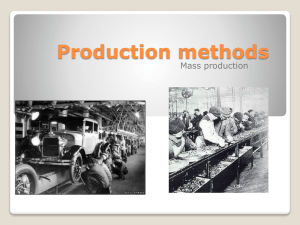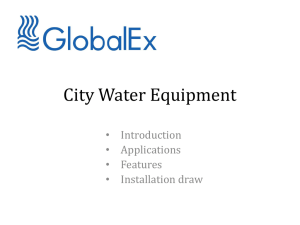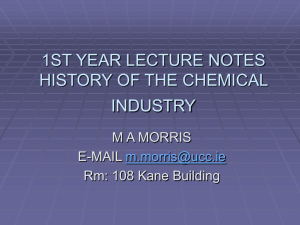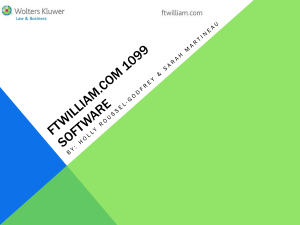The Industrial Manufacture of Chemical Compounds
advertisement
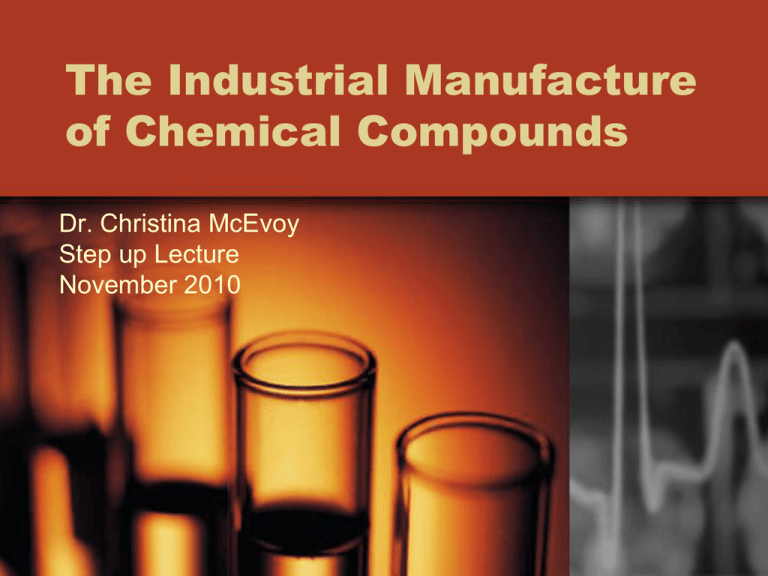
The Industrial Manufacture of Chemical Compounds Dr. Christina McEvoy Step up Lecture November 2010 Contents • What factors do we need to consider in design of a plant? • Types of industrial processes • What factors are important in running a plant? Key design factors • • • • • What do we want to make? In what quantities? How will we manufacture? How can we ensure safe production? What environmental considerations are there? • What are the costs associated with the project? • How will we run the plant (people and shifts)? What and how much do we want to make? • Will this plant make only one product or many products? – Examples sulphuric acid, sodium hydroxide, dyestuffs, perfumes • How much will we make? – 10g, 10kgs or 10,000T The answers to these questions will determine how we will manufacture Manufacturing processes • Batch process - A process that is not in continuous or mass production; operations are carried out with discrete quantities of material or a limited number of items (1T of X and 2T of Y) • Continuous process -Industrial process that continuously receives raw materials and processes them through to completed units (1T/h of X and 2T/h of Y) Manufacture of Aspirin – batch process Examples of batch processes • • • • • • • Pharmacuticals Agrochemicals Dyestuffs Food additives Perfumes Vitamins Pigments Advantages of batch processes • Good for small amounts of speciality chemicals • Make a range of products using same equipment • Good for developing new products • Easier to scale up from lab scale • Generally cheaper set up costs Disadvantages of batch processing • Frequent start up and shutdown of equipment • Cleaning time between batches • May be batch to batch variability • Not good for bulk chemical production Examples of Continuous Processes • • • • • • Sulphuric acid production Sodium hydroxide production Ammonia Petrol Chlorine Methanol Advantages of Continuous Processing • Good for large volumes (bulk chemicals) • Fewer start up and shutdowns • Potentially greater yields • Potentially easier to maintain quality or spot out of specification product sooner Disadvantages of Continuous Processing • Requires periodic shutdown of whole plant for inspection and maintenance • May rely on critical pieces of equipment which have the potential to stop production on whole plant • Higher initial costs Designing in Safety • Sets of legal and business standards to which plants must comply • Process Safety Management • What if? • Risk assessment Key at the design stage is to review proposed design, identify hazards and engineer them out. If the hazard cannot be eliminated then the risk must be reduced using various means. Examples of Safety Devices • • • • • • • • • Relief Valves Rupture discs Conservation vents Failsafe logic Process Interlocks Alarms, monitoring of process conditions Physical barriers Personal Protective Equipment (PPE) Training of personnel Key Environmental Considerations • International/national laws • Governmental conditions (licence to operate) • Again key is to eliminate or minimise at design stage. • If can’t eliminate then must look at containment and treatment. What will this Cost? • Fixed Capital investment – Total cost of the plant ready for start up. • Working Capital investment – additional investment required over and above fixed capital to start the plant up and operate it to a point where income is generated. Types of Costs Fixed Capital Investment Working Capital Investment 1. Concrete and steel 1. Start up 2. Equipment 2. Initial catalyst charges 3. Piping 3. Raw materials 4. Instrumentation 4. 5. Buildings for process and other eg offices Finished Product Inventories 6. Storage facilities 7. Utilities provision 8. 9. Non Capital Investment 1. People involved in start up Design and engineering costs 2. Travel Contractors fees 3. Training An Oil Refinery Photo courtesy Phillips Petroleum Company http://science.howstuffworks.com/oil-refining.htm/printable Fractional distillation of Crude Oil BP America Refinery Explosion Location: Texas City, TX March 23, 2005 http://www.csb.gov/assets/investigation/original/CSB_Photo-Destroyed_Trailers_BP_Near_Isom_Unit.JPG Accident Description • At approximately 1:20 p.m. on March 23, 2005, a series of explosions occurred at the BP Texas City refinery during the restarting of a hydrocarbon isomerization unit. Fifteen workers were killed and 180 others were injured. Many of the victims were in or around work trailers located near an atmospheric vent stack. The explosions occurred when a distillation tower flooded with hydrocarbons and was overpressurized, causing a geyser-like release from the vent stack. For more details see: http://www.csb.gov/investigations/detail.aspx?SID=20&Type=2&pg=1&F_All=y Chlor-Alkali HCl Product Hydrogen Handling HCl Production HCl Storage Chlorine Compression Chlorine Liquefaction Chlorine Storage Hypo Production Hypo Storage Hypo Product Caustic Storage Caustic Product Sulphuric Acid Carbon Dioxide NaOH Chlorine Drying Salt Demin. Water To Hypo Brine Saturation Primary Treatment Secondary Treatment Chlorine Packing, Filling Vaporization Chlorine Product Sulphuric Acid Sodium Sulphite Sulphate Removal HCl Electrolysis NaOH Brine Dechlorination Caustic Concentration Chlorate Destruction Demineralized Water AC Power Supply HCl DC Rectification Hypo Destruction CHEMETICS http://www.akerkvaerner.com/NR/rdonlyres/A078B10E-6369-48E5-9E2D-ECD2BFE2E628/12091/ProcessFigure1.PPT Electrolysis http://encarta.msn.com/media_461541587/Chloralkali_Electrolysis.html Agrochemical Production • Bulk chemicals production –how do you think you would manufacture? • Fertilisers – what hazards exist in design and production? The Haber Process N2(g) + 3H2(g) → 2NH3(g) ΔHo = -92.4 kJ/mol •Reversible Reaction • Exothermic reaction – best yield obtained at lower temperatures but rate of reaction is too slow so increased temperature is used. • Catalyst is used to help speed up the reaction rate • Increased pressure increases yield What do you think are the key variables to control during production? Recent Incident Explosion at Terra Nitrogen (UK) Ltd, Billingham 01.06.2006 Terra Nitrogen is the UK's largest manufacturer of nitrogen products used extensively in the chemical industry and agriculture and employs around 250 people on Teesside. The incident happened on a pipe at the plant and led to a fire involving mixed gases including hydrogen, nitrogen and a small amount of ammonia which was extinguished automatically as the pipe depressurised. The exact cause of the blast is not yet clear. The HSE are currently investigating with the Environment Agency (EA). How will we run the plant? • Will it be 24/7 operation? • How many people? • What skills do they require (operating technicians, maintenance technicians, engineers)? • What support staff (HR, admin,finance, IT)? Aim of Production To make first time, first quality product, safely, with maximum yield Key monitoring conditions • • • • • • Pressures Temperatures Flows pH Concentrations Mixing rates Running Costs Fixed costs – Costs which are paid regardless of production rate Variable Costs – Costs related to production • Labour costs • Raw materials • Maintenance costs • Utilities • Admin costs (insurances, rates, taxes) • Packaging • Storage and distribution Questions?
